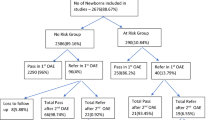Abstract
Hearing loss is hidden disability and second most common congenital pathology. Prevention, early identification and early intervention of hearing loss can prevent further disability in development of speech, language, cognition and other developmental domains. The prevalence of congenital hearing loss has been estimated to be 1.2–5.7 per thousand in neonates. In these contexts, the aim of study was to determine outcomes of neonates hearing screening program in Hospital. It is a clinical cross-sectional study which was conducted in tertiary care centre from 8th July, 2015 to 31th May, 2016. Total no of 2254 cases were screened. Details case history including high risk register, Pediatric Audiometry, Otoacoustic Emission tests were performed followed brainstem evoked response audiometry. The Prevalence of hearing loss among high risk babies confirmation by BERA was 8.8% per 1000 babies and 16 cases were recommended for Cochlear Implant. The screening protocol with objective test i.e. Distortion Product Otoacoustic Emission and confirmation by Brainstem Evoked Response Audiometry is very useful tool in early identification of congenital hearing loss in neonates. Hence, the results of this study will be used to initiate universal newborn hearing screening in other hospitals. Moreover, this study highlights the relevance of neonatal hearing screening in other states of India and country where this screening is not performed routinely in all hospitals and creating awareness to identify neonatal risk factors associated with hearing loss and understand the importance of early identification and early intervention and among health care professionals.



Similar content being viewed by others
References
Shemesh R (2010) Hearing impairment: definitions, assessment and management. Int Encycl Rehabil
Parving A (1993) Congenital hearing disability: epidemiology and identification—a comparison between two health authority districts. Int J Pediatr Otorhinolaryngol 27:29–46
Kim SY, Bothwell NE, Backousn DD (2002) The expanding role of the otolaryngologist in managing infants and children with hearing loss. Otolaryngol Clin N Am 35:699
Hayes D (1999) State programs for universal newborn hearing screening. Pediatr Clin N Am 46:89–94 (PubMed: 10079792)
American Speech language Hearing Association (2008) Loss to follow up in early hearing detection and Intervention
Joint Committee on Infant Hearing (2007) Year 2007 position statement: principles and guidelines for early hearing detection and intervention programs. Pediatrics 120(4):898–921
American National Standards Institute (ANSI) (1991) Maximum permissible ambient noise levels for audiometric test rooms. ANSI S3.1-1991. ANSI, New York
Grill E, Hessel F, Siebert U, Schnell-inderst P, Kunze S, Nickisch A, Wasem J (2005) Comparing the clinical effectiveness of different newborn hearing screening strategies. A decision analysis. BMC Public Health 5(1):12
Nagapoornima P, Ramesh A, Rao S, Patricia PL, Gore M et al (2007) Universal hearing screening. Indian J Pediatr 74:545–549
Mehra S, Eavey RD, Keamy DG Jr (2009) The epidemiology of hearing impairment in the United States: newborns, children, and adolescents. Otolaryngol Head Neck Surg 140:461–472
Indian Council of Medical Research Report (1983) Collaborative study on prevention and etiology of hearing impairment. Indian Council of Medical Research, New Delhi
Paul AK (2011) Early identification of hearing loss and centralized newborn hearing screening facility: the Cochin experience. Indian Pediatr 48:355–359
Rai N, Thakur N (2013) Universal screening of newborns to detect hearing impairment: Is it necessary? Int J Pediatr Otorhinolaryngol 77:1036–1041
Jerger S, Roeser RJ, Tobey EA (2001) Management of Hearing Loss in Infants: The UTD/Callier Center Position Statement. J Am Acad Audiol 12:329–336
Papsin BC, Gordon KA (2007) Cochlear implants for children with severe-to-profound hearing loss. N Engl J Med 357:2380–2387
Colella-Santos MF, Hein TAD, Souza GLD, Amaral MIRD, Casali RL (2014) Newborn hearing screening and early diagnostic in the NICU. Biomed Res Int 2014:1–11
Salamy A, Eldredge L, Tooley WH (1989) Neonatal status and hearing loss in high-risk infants. J Pediatr 114(5):847–852
Cristobal R, Oghalai JS (2008) Hearing loss in children with very low birth weight: current review of epidemiology and pathophysiology. Arch Dis Child Fetal Neonatal Ed 93(6):F462–F468
Garg S, Singh R, Khurana D (2015) Infant hearing screening in India: current status and way forward. Int J Prev Med 6(1):113
Authors Contribution
The manuscript has been read and approved by all the authors, that the requirements for authorship as stated earlier in this document have been met, and that each author believes that the manuscript represents honest work.
Author information
Authors and Affiliations
Corresponding author
Ethics declarations
Conflicts of interest
None.
Ethical Standards
All the author have seen and approved the final version of manuscript being submitted there is no conflict of interest or financial interest of authors. Consent of parents is taken to use the clinical material for publishing. No animals were harmed during the publications. Publication is done in accordance with the Ethical Committee guidelines.
Rights and permissions
About this article
Cite this article
Sachdeva, K., Sao, T. Outcomes of Newborn Hearing Screening Program: A Hospital Based Study. Indian J Otolaryngol Head Neck Surg 69, 194–198 (2017). https://doi.org/10.1007/s12070-017-1062-0
Received:
Accepted:
Published:
Issue Date:
DOI: https://doi.org/10.1007/s12070-017-1062-0




